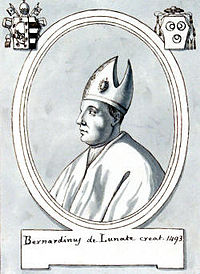Bernardino Lunati


Bernardino Lunati (1452–1497) was an Italian Roman Catholic cardinal.
Biography
Bernardino Lunati was born in Pavia in 1452.[1] Early in his career, he was a protonotary apostolic.[1]
He obtained the patronage of Cardinal Ascanio Sforza, who insisted that Lunati be made a cardinal.[1] As such, Pope Alexander VI made him a cardinal deacon in the consistory of September 20, 1493.[1] He received the red hat and the titulus of San Ciriaco alle Terme Diocleziane on September 23, 1493.[1] Immediately after he was raised to the cardinalate, Lunati was ordained as a priest.[1]
He supported Cardinal Ascanio Sforza in Cardinal Sforza's dispute with the pope.[1] He was detained after visiting the Apostolic Palace on December 9, 1494.[1] However, he was allowed to participate in the consistory of December 11, 1494 and was then sent to Ostia.[1] From there, he joined Charles VIII of France and was part of his entourage when he entered Rome on December 31, 1494.[1] Following the agreement reached between the pope and the king on January 15, 1495, Cardinal Lunati traveled with Cardinal Sforza to Milan, returning to Rome with him on February 21, 1495.[1] He accompanied the pope to Orvieto on May 27, 1495 and returned with him to Rome on June 27.[1]
On July 10, 1495, he was named apostolic administrator of the see of Aquino, holding this post until November 13, 1495.[1] In the consistory of October 26, 1496, he was named papal legate to Guidobaldo da Montefeltro, Duke of Urbino, captain general of the papal troops, in the war against the Orsini family.[1] He was with the duke for the occupation of Anguillara Sabazia, Galera, Bassano, Sutri, Campagnano di Roma, Formello, Sacrofano, and Cesena.[1]
He died during the siege of Bracciano, on August 8, 1497.[1] He is buried in Santa Maria del Popolo.[1]
